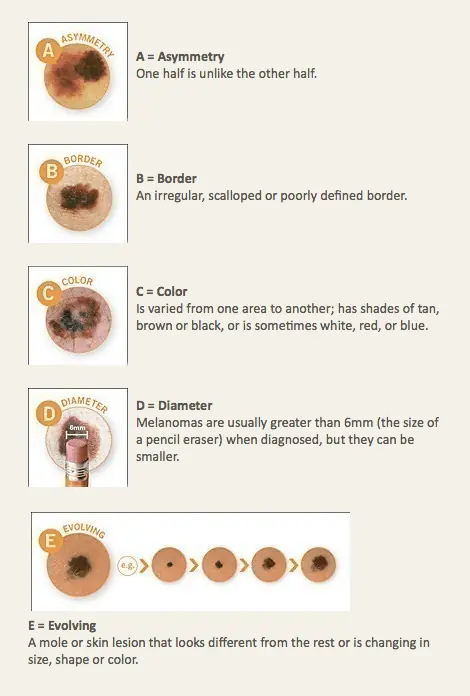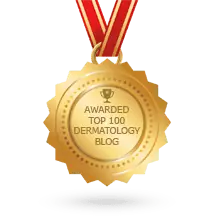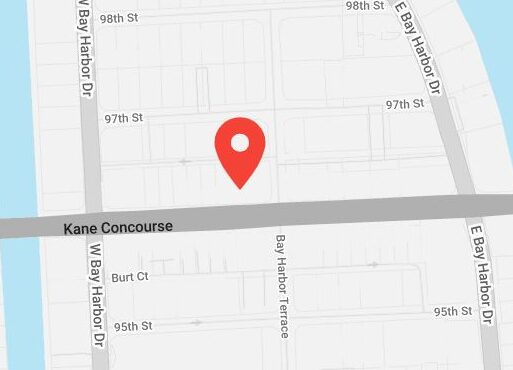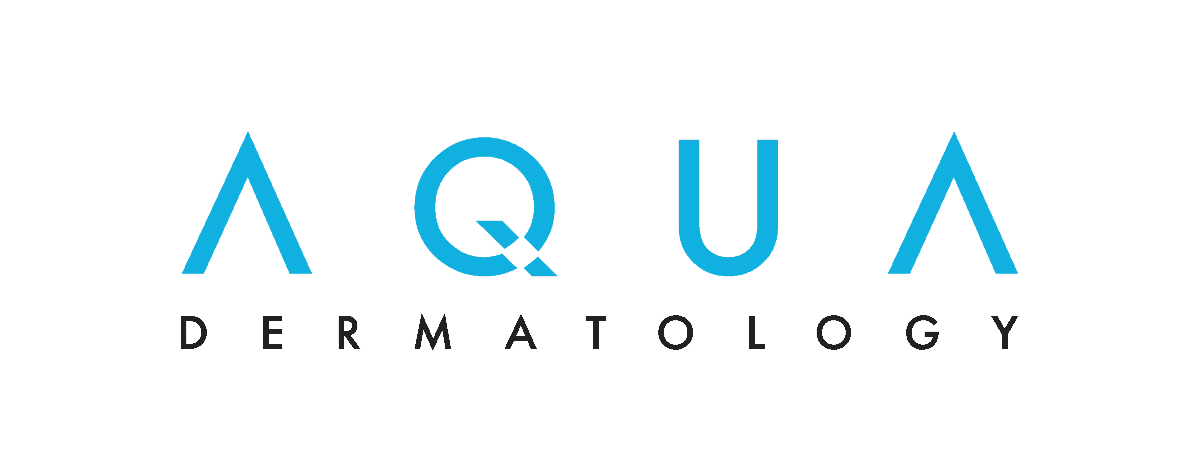Skin cancer is the most common form of cancer, and it is becoming even more common. Over the last forty years, rates of skin cancer have increased by over 200%, and they’re growing even faster among younger people. Fortunately, skin cancer is also one of the most treatable forms of cancer. With the right knowledge and professional help, you can have the best opportunity for simple and successful treatment.
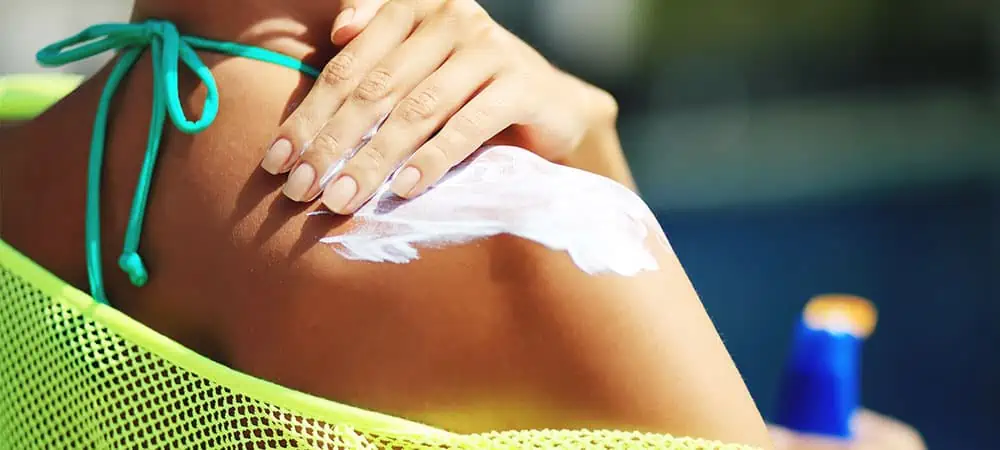
The ABCDE’s of Melanoma
Skin cancer types
There are many kinds of skin cancer, but the three most common are basal cell carcinoma skin cancer, squamous cell skin cancer carcinoma, and melanoma.
Basal cell carcinoma is the most common type of skin cancer, especially among people with fair skin. It occurs on the innermost layer of the epidermis, called the basal layer, and typically occurs on places that get a lot of sun exposure such as the face.
Squamous cell carcinoma is the second most common type of skin cancer. It affects the squamous cells of the skin, which are flat cells that make up most of the epidermis. In people with dark skin, it is normally found on areas that aren’t usually exposed to the sun such as the feet, but in light-skinned people it usually occurs on areas of chronic sun exposure such as the face, scalp, and hands.
While melanoma is the most dangerous and well-known type of skin cancer, it is less common than basal cell and squamous cell carcinoma. Melanoma affects pigment-producing cells and can occur on any skin surface. There are four basic types of melanomas: superficial spreading, acral lentiginous, lentigo maligna, and nodular. Overall, superficial spreading melanoma is the most common type of melanoma (approximately 70% of cases) and is most often seen in young people. It grows along the top layer of the skin before it becomes invasive and penetrates the skin more deeply. Lentigo maligna melanoma is most often seen in the elderly and is found on chronically sun-exposed sun damaged skin of the face, ears, and arms. Similar to superficial spreading melanoma, it may remain in situ for a long period of time before becoming invasive. Acral lentiginous melanoma is the most common type of melanoma in African-Americans and Asians and appears as a black or brown discoloration under the nails or on the palms and/or soles. It may spread superficially before becoming invasive but is often diagnosed late and may already be invasive at that time. Nodular melanoma is the most aggressive type of melanoma and accounts for between 10-15% of cases. It is usually invasive at the time of diagnosis.
Skin cancer symptoms
Skin cancer is usually noticeable as a growth or discolored patch on the skin that is new or changed from its normal appearance. The specific appearance depends on the type of skin cancer, but common types are waxy or shiny bumps, tan or brown lesions, red nodules, crusty, scaly or ulcerated/eroded patches, and large dark spots with darker speckles. Moles that change shape or color are also a warning sign. If you notice anything on your skin that was not there before, it’s a good idea to have it checked out to be sure it’s not cancerous.
[testimonial post_list=”6038″ display_type=”carousel” truncate=”300″ include_rating=”true”]
Skin Cancer FAQs
How is skin cancer diagnosed?
A skin examination will help determine if you have any spots on your skin that are suspicious for skin cancer. The use of dermoscopy – a hand help microscope and light device – can aid in the evaluating skin lesions. The only want to diagnose a skin cancer, including basal cell carcinoma, squamous cell carcinoma and melanoma, is with a skin biopsy.
What is a basal cell carcinoma?
Basal cell carcinoma (BCC) is the most common form of skin cancer. BCC is more common in individuals with fair skin, light head and/or eyes and usually develops on sun exposed skin. Common sites for BCC include the face (especially the nose), neck, chest, back, arms and legs though they can develop on any part of the body.
What does a basal cell carcinoma look like?
BCC has several clinical forms with different appearances on the skin, including nodular (translucent dome shaped growth with visible blood vessels), pigmented (brown or black growth), superficial (reddish scaly patch – may be mistaken for a patch of eczema), sclerosing BCC (may be pink-white and looks like a scar). Lesions may bleed easily, crust or ulcerate.
BCC is a slow-growing cancer which rarely spreads to other areas of the body but may become locally destructive, destroying skin tissue and underlying connective tissue and bone.
What is a squamous cell carcinoma?
Squamous cell carcinoma (SCC) is the second most common type of skin cancer in the United States. Chronic sun exposure is the primary risk factor for the development of SCC. Other factors that may predispose to SCC include burns, scars, immunosuppression, chronic inflammatory conditions and radiation.
What does a squamous cell carcinoma look like?
Squamous cell carcinoma occurs on sun-exposed areas of the face and body including the scalp, face, lips, ears, chest, backs of hands, and lower legs. SCC has a variety of clinical presentations including red scaly patches of skin, elevated thickened growths with central depression or ulceration, open sores, nodules or wart-like growths.
Skin cancer treatment
Skin cancer is the most common type of cancer in humans and its incidence is rising with 1 in 5 Americans affected. The good news is that skin cancer is highly curable when detected early and there are many highly effective treatments at our Miami dermatology office. We are certified by the American Board of Dermatology and perform full body skin cancer screening. Skin cancer screening consists of full body exams including the use of a dermatoscope (a hand help instrument for examining moles and certain types of skin cancers).
After a diagnosis of basal cell carcinoma, squamous cell carcinoma or melanoma has been confirmed with biopsy, your dermatologist will discuss treatment options with you. There are several factors including size, location and subtype of skin cancer, your age and health, that will help your dermatologist determine which treatment is best for you. Treatment options include:
Topical immunomodulators
For certain types of skin cancers, topical immunomodulators such as immiquimod, may be used. This is usually done over several weeks and close clinical follow-up is necessary to ensure that the skin cancer has been treated.
Excision
This is a surgical procedure that can be performed during a dermatologist office visit. The affected area will be numbed and any remaining tumor plus some normal looking skin will be removed. The tissue will be sent to the laboratory and examined under the microscope to ensure that the entire skin cancer has been removed.
Mohs surgery
Mohs surgery is a specialized type of surgery which offers the highest cure rate for BCC and SCC. During this procedure, the affected area will be numbed and the skin cancer will be removed with a very small amount of normal-looking skin surrounding the tumor. The tissue will be mapped and completely examined under the microscope to ensure the cancer is removed. The Mohs surgeon will continue to remove very small amounts of skin until the margins are clear of cancer. After the skin cancer has been completely removed, the resulting defect may be closed by your dermatologist or by a plastic surgeon to ensure an esthetic outcome.
Curettage and electrodessication
This is a surgical procedure that can be performed during a dermatologist office visit. The affected area will be numbed and the treatment consist of two steps. First, your dermatologist scrapes away the tumor. Then, electricity is used to destroy any remaining skin cancer cells. This is repeated for a total of three cycles.
Other considerations
Additional more intensive work-up and treatment including sentinel lymph node dissection and imaging studies may be required for melanoma depending on the type of melanoma and depth in the skin. Come meet with esteemed cosmetic dermatologist Dr. Diane Walder and her colleague, Dr. Chimento, in Miami. Dr. Walder is an authority on skincare, and is often quoted in major publications like Allure and Glamour. Dr. Walder has helped many people protect against and repair from the effects of the Florida sun, aging, and the daily stresses of life on skin. If you’re serious about a lifetime of beautiful skin, call (305) 866-2177 today to schedule you appointment.
